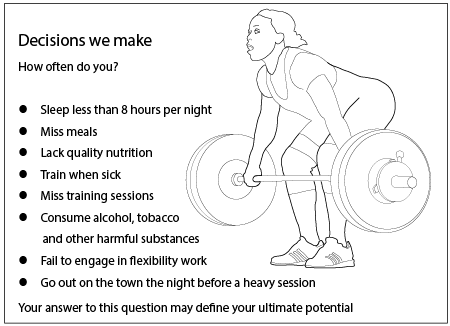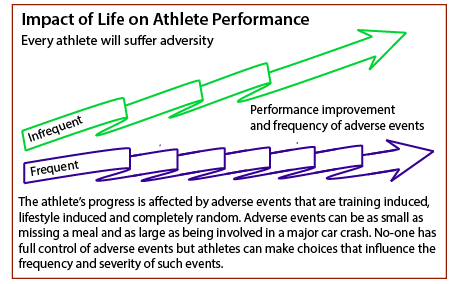Impact of Life on Training
It is a great feature of life that we do not know the future. All we can do is to make moment-to-moment decisions that we think are in the best interests of ourselves, those we love, and hopefully the planet. The decisions we make stem from what we have learned, our personal motivations and, more than we know, the pressure we experience by living in society.
For the athlete who is ambitious and progressing through the various performance strata, we begin to see observable changes in decision making. Buoyed by the expectation of success, the athlete begins to demonstrate not only increased commitment to their sport training but also the capacity to make different decisions about their life more generally. While there is an understanding in the community that success in sport requires the athlete to make “sacrifices”, there is insufficient knowledge of how such sacrifices are played out in the moment-to-moment decision making of the athlete. To progress towards the top, the athlete must step their way forward through a minefield of endless risks, large and small, and because the future is unknowable it is inevitable that the athlete will suffer adverse events.
 There are some adverse events, such as injury and illness, which athletes readily understand to be detrimental to their training and performance. This is because the effect is immediate and highly noticeable, and as a result athletes seek to avoid any occurrence. However, there are also adverse events, the effects of which seem small, temporary and inconsequential when considered in isolation. A loss of sleep, a meal missed, exercise poorly performed and an alcoholic binge are all examples which athletes suffer regularly. But what is not so well understood by athletes is that if these adverse events occur frequently, the cumulative effect can depress long-term progress in the sport just as much as infrequent events of a greater magnitude in adversity. Loss of sleep and inadequacy of diet are factors that undoubtedly impact on the athlete’s ability to recover from intense training, and recovery is of paramount importance for benefits of training to be realised. Athletes need to know that training is catabolic, that is it causes breakdown of tissue in the body. The anabolism needed to complete the training process takes place outside of the training hall. There is a delicate balance between catabolism and anabolism, and when an athlete fails to improve over time despite regularly high intensity training, as a coach you know there is something wrong.
There are some adverse events, such as injury and illness, which athletes readily understand to be detrimental to their training and performance. This is because the effect is immediate and highly noticeable, and as a result athletes seek to avoid any occurrence. However, there are also adverse events, the effects of which seem small, temporary and inconsequential when considered in isolation. A loss of sleep, a meal missed, exercise poorly performed and an alcoholic binge are all examples which athletes suffer regularly. But what is not so well understood by athletes is that if these adverse events occur frequently, the cumulative effect can depress long-term progress in the sport just as much as infrequent events of a greater magnitude in adversity. Loss of sleep and inadequacy of diet are factors that undoubtedly impact on the athlete’s ability to recover from intense training, and recovery is of paramount importance for benefits of training to be realised. Athletes need to know that training is catabolic, that is it causes breakdown of tissue in the body. The anabolism needed to complete the training process takes place outside of the training hall. There is a delicate balance between catabolism and anabolism, and when an athlete fails to improve over time despite regularly high intensity training, as a coach you know there is something wrong.
Many researchers have attempted to pinpoint what drives an athlete to phenomenal levels of success. There is always great interest in the training done, and also in the psychological make-up of the athlete. But if only we could better understand and record the moment-to-moment decisions that athletes make, we would better understand the true nature of problem.
Leo Isaac
